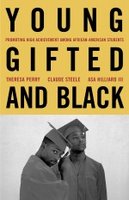One of the greatest challenges facing our communities is the refusal to discuss what the real problems are. In his NYTimes article Bob Herbert starts that conversation
Published: August 24, 2006
I was browsing at a newsstand in Manhattan recently when I came across a magazine called Felon. It was the “Stop Snitchin’ ” issue, and the first letter to the editor began: “Yo, wassup Felon!”

Bob Herbert.
Another letter was from “your nigga John-Jay,” who was kind enough to write: “To my bitches, I love ya’ll.”
Later I came across a magazine called F.E.D.S., which professes to be about “convicted criminals—street thugs—music—fashion—film—etc.” The headline “Stop Snitching” was emblazoned on the cover. “Hundreds of kilos of coke,” said another headline, “over a dozen murders,” and “no one flipped.”
What we have here are symptoms of a depressing cultural illness, frequently fatal, that has spread unchecked through much of black America.
The people who are laid low by this illness don’t snitch on criminals, seldom marry, frequently abandon their children, refer to themselves in the vilest terms (niggers, whores, etc.), spend extraordinary amounts of time kicking back in correctional institutions, and generally wallow in the deepest depths of degradation their irresponsible selves can find.
In his new book, “Enough,” which is about the vacuum of leadership and the feverish array of problems that are undermining black Americans, Juan Williams gives us a glimpse of the issue of snitching that has become an obsession with gang members, drug dealers and other predatory lowlifes — not to mention the editors of magazines aimed at the felonious mainstream.
“In October 2002,” he writes, “the living hell caused by crime in the black community burst into flames in Baltimore. A black mother of five testified against a Northeast Baltimore drug dealer. The next day her row house was fire-bombed. She managed to put out the flames that time. Two weeks later, at 2 a.m. as the family slept, the house was set on fire again. This time the drug dealer broke open the front door and took care in splashing gasoline on the lone staircase that provided exit for people asleep in the second- and third-floor bedrooms.
“Angela Dawson, the 36-year-old mother, and her five children, aged 9 to 14, burned to death. Her husband, Carnell, 43, jumped from a second-story window. He had burns over most of his body and died a few days later.”
If white people were doing to black people what black people are doing to black people, there would be rioting from coast to coast. As Mr. Williams writes, “Something terrible has happened.”
When was it that the proud tradition of Frederick Douglass and W. E. B. DuBois, Harriet Tubman and Mary McLeod Bethune, Louis Armstrong and Billie Holiday and Duke Ellington, Martin Luther King and Thurgood Marshall, gave way to glossy felon magazines and a shameful silence in the face of nationally organized stop-snitching campaigns?
In an interview, Mr. Williams said: “There are so many things that we know are indicators of a crisis within the community. When you look at the high dropout rate, especially among our boys. Or the out-of-wedlock birthrate, which is really alarming. Or the high rate of incarceration.
 “When you hear boys saying it’s a ‘rite of passage’ to go to jail, or the thing that is so controversial but has been going on for a while — kids telling other kids that if they’re trying to do well in school they’re trying to ‘act better than me,’ or ‘trying to act white’ — all of these are indications of a culture of failure. These are things that undermine a child or an individual who is trying to do better for himself or herself. These are things that drag you down.”
“When you hear boys saying it’s a ‘rite of passage’ to go to jail, or the thing that is so controversial but has been going on for a while — kids telling other kids that if they’re trying to do well in school they’re trying to ‘act better than me,’ or ‘trying to act white’ — all of these are indications of a culture of failure. These are things that undermine a child or an individual who is trying to do better for himself or herself. These are things that drag you down.”
Enough, in Mr. Williams’s view, is enough. His book is a cry for a new generation of African-American leadership at all levels to fill the vacuum left by those who, for whatever reasons, abandoned the tradition of struggle, hard-won pride and self-determination. That absence of leadership has led to an onslaught of crippling, self-destructive behavior.
Mr. Williams does not deny for a moment the continued debilitating effects of racism. But racism is not taking the same toll it took a half-century ago. It is up to blacks themselves to embrace the current opportunities for academic achievement and professional advancement, to build the strong families that allow youngsters to flourish, and to create a cultural environment that turns its back on crime, ignorance and self-abasement.
More blacks are leading successful lives now than ever before. But too many, especially among the young, are caught in a crucible of failure and degradation. This needs to change. Enough is enough.
The Cultural Crisis in Black America
(5 Letters)
Published: August 28, 2006
To the Editor:
Re “A Triumph of Felons and Failure,” by Bob Herbert (column, Aug. 24): Mr. Herbert’s description of the new book “Enough,” by Juan Williams, is excellent. It is about “the vacuum of leadership and the feverish array of problems that are undermining black Americans,” and it is timely and exceedingly important.
We are all in the midst of a “cultural illness” that is “frequently fatal.” To call it a “culture of failure” among our youth is sadly apt. It is a culture of swagger and insecurity. It is a culture that seems to promote a complete misunderstanding of what it means to be a man or a woman.
There are many individuals who work bravely and brilliantly and lovingly each day to remedy this situation and they are surely our greatest heroes. But we have needed courageous and honest and visible leadership for a very long time now.
Connie Ban
Princeton, N.J., Aug. 24, 2006
•
To the Editor:
Bob Herbert tells the heart-wrenching story of a woman whose family was killed as payback for testimony against a Baltimore drug dealer in 2002. He advocates a cultural shift in a swath of urban, black America, saying “it is up to blacks themselves” to “create a cultural environment that turns its back on crime.”
Unfortunately, it will be difficult for such change to occur until we rethink our disastrously failed drug war. Under the current policy of prohibition, there is an enormous economic incentive for people to turn to dealing drugs.
Just as happened during the era of alcohol prohibition, dealers arm themselves and form powerful gangs that infest every corner of our society. Without prohibition, those dealers would be out of business.
Sam Ehrlichman
Ithaca, N.Y., Aug. 25, 2006
•
To the Editor:
It took a lot of courage for Bob Herbert to write about black street culture in these days of restrictive political correctness.
I taught in a district that was predominantly African-American for 22 years. I was determined to foster literacy in our public schools, and I became a reading specialist. What was very disheartening was the predominance of street culture and how it dominated the attitude of too many black children and their parents.
Most of the remedial kids I worked with in predominantly black neighborhoods did not value book learning, and neither did their parents. The reading at home required as part of the program was rarely done. Most of these children did learn to read, but they may never catch up to peers whose parents started reading to them in infancy and later made sure that there was homework time.
Yes, values make more of a difference than money. My parents didn’t get past the sixth grade but they valued books and an education and I am so grateful to them.
Janet Robinson
Mahopac, N.Y., Aug. 24, 2006
•
To the Editor:
Our media producers cater to thugs, and our government hierarchies let petty urban warlords terrorize and rule. Let a race of men arise, yes, but the responsibility belongs to those producers and leaders who could start something.
It is not an absence of “African-American leadership.” It is a complex array of national-state-regional-municipal problems that political leaders (and business leaders) refuse to confront.
Stuart Filler
Birmingham, Mich., Aug. 24, 2006
•
To the Editor:
Bob Herbert echoes a familiar call for a “new generation of African-American leadership.” While I understand the motivation, I disagree with the conclusion.
Must leaders and role models necessarily be drawn strictly on the basis of race? Cannot a Hindu woman or a person of Middle Eastern descent or even a white man act as a leader of a generation of disenfranchised youth? In other words, can the vacuum of leadership not be filled from the rich and diverse fabric of American society and beyond?
Until this insular notion that African-Americans — or any other group, for that matter — can be led only by people of a particular race, class or religion is overcome, the problems that Mr. Herbert seeks to address will continue to persist. I say indeed, enough is enough.
Kevin P. McNeil
New York, Aug. 25, 2006

 A huge portion of the school reform debate in America-explicitly and implicitly—is framed around the success and failure of African-American children in school. The test-score "achievement gap" between white and black students, especially, is a driving and divisive issue. Yet the voices of prominent African-American intellectuals have been conspicuously left out of the debate about black children.
A huge portion of the school reform debate in America-explicitly and implicitly—is framed around the success and failure of African-American children in school. The test-score "achievement gap" between white and black students, especially, is a driving and divisive issue. Yet the voices of prominent African-American intellectuals have been conspicuously left out of the debate about black children.








































